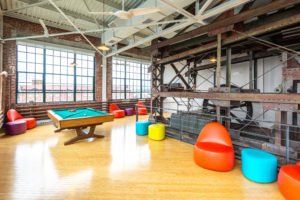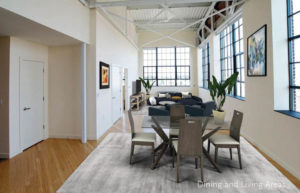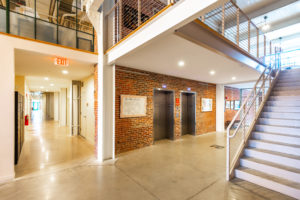May 31, 2022
Reading Time: 6 minutes
Roebling Lofts .Photo by CCH

Roebling Lofts. Photo by CCH
New Jersey has a rich and varied architectural history and a wealth of historic buildings of all types and sizes- from modest homes to large factories. Over time, what is one to do with these buildings? According to the National Park Service, buildings are either “modernized” for new use (rehabilitated) or are abandoned, often to the wrecking ball. More and more, the trend is to rehabilitate existing historic structures. According to the Architectural Billing Index (ABI), the bulk of architectural billings has been on existing buildings rather than new construction for the first time in decades.
If an owner decides to rehabilitate a building, and the building is certified as historic, the guiding document for design in the Secretary of the Interior’s Standards for Rehabilitation. Pursuant to the Standards, “A property shall be used for its historic purpose or be placed in a new use that requires minimal change to the defining characteristics of the building and its site and environment.” Most rehabilitations involve changing a building’s historic use, for example from industrial to multi-unit residential. A good example is the Roebling Lofts project in Trenton, New Jersey. This building had been built to manufacture small diameter wire rope and now houses 138 loft apartments. Countless other buildings in New Jersey are well-suited for this type of conversion.
Why rehabilitate? The reasons are compelling. Older buildings have intrinsic value, often made from higher quality materials that are too expensive to use today. The warmth of those materials attracts people; the history resonates, making the structures more interesting. Keeping a building maintains a sense of place, a reminder of a city’s history and culture. In addition, existing buildings contain embodied carbon. Therefore, one of the most sustainable construction activities you can do is to repurpose a building, thus reusing the carbon. If demolished, not only is the historic character of the building lost forever but its embodied carbon is wasted.
Every building has a story to tell, a story of its purpose, its occupants, and its evolution. There are numerous structures in dire need of rehabilitation, just as there is a tremendous need for housing. Repurposing older, historic structure is a win-win, creating sustainable, livable housing while preserving valuable historic artifacts, upgrading existing conditions, and giving new life and new use to underutilized spaces. Roebling Lofts is a good example of how to achieve these goals.

Roebling Lofts. Photo by CCH
Led by John Hatch, FAIA, and David Henderson, AIA, HHG Development transformed the long-vacant Building 101 of Trenton’s historic Roebling Complex into a hub of activity, creating a vibrant live-work environment with its double-height loft apartments, tenant amenities, and a unique fourth-floor lounge highlighted by the former aircraft cable fatiguing machine. Designed by Clarke Caton Hintz, the loft apartments preserve the character of the former factory, taking practical advantage of the large industrial sash windows that dominate the façade.
Rehabilitating historic structures, often located in cities and urban areas, allows a project to create more livable, walkable communities. Roebling Lofts is ideally located close to the Roebling Market and is adjacent to a light rail station providing mass transportation on site. The project is the first of many redevelopment efforts of Block 3 within the Roebling Complex, already attracting new businesses to the area.
The building is listed on the New Jersey State and National Registers of Historic Places and the renovation was made possible through the use of Federal Historic Tax Credits. The project is also certified LEED Gold.

Michael Hanrahan, AIA has been a key member of Clarke Caton Hintz for over twenty years. Michael has led many of the firm’s notable architecture projects, working at a variety of scales and typologies across numerous market sectors. In particular, he has provided leadership in giving new life to historic buildings, solidifying their continuing place and making them relevant to future generations. Past award-winning projects include the restoration of the Historic Hunterdon County Courthouse, home of the famed Lindbergh baby kidnapping trial of the 1930’s, and 200 Elm Drive, the adaptive re-use of the former Princeton University boilerhouse as new University administrative offices.
Michael Hanrahan embraces the challenge of working with existing buildings, following their design cues and developing creative solutions to the conflict between historic buildings and contemporary needs. In addition, in new construction, he seeks to understand the authenticity and sense of place for each project, transforming underutilized structures and sites into better versions of themselves. Noteworthy new and revitalization projects include Engineering Hall, a new engineering teaching and research facility for the Henry M. Rowan College of Engineering at Rowan University; the renovation and reimagining of the middle school for The Hun School of Princeton; and Victory Hall, the renovation and expansion of the competition gymnasium for Mercy College.
Mr. Hanrahan has been actively involved with the New Jersey chapter of the American Institute of Architects (AIA-NJ) since 1999. Michael rose to AIANJ President in 2011 and was recognized in 2012 as a recipient of the AIA National Young Architect Award. Currently, he is the New Jersey Regional Representative to the National AIA Strategic Council, assisting the architecture profession on important, upcoming professional issues and opportunities. In addition, Michael is a Past President of Preservation New Jersey, a statewide nonprofit organization promoting economic vitality, sustainability and heritage of New Jersey’s diverse communities.
Mr. Hanrahan obtained a Bachelor of Architecture, with Honors, from the New Jersey Institute of Technology in 1996. Simultaneously, he earned a dual degree garnering a Master of Science in Management in the same year.
Facebook: @AIANJ
Twitter: @AIANJ
Instagram: AIA New Jersey
Linkedin: AIA New Jersey
Architects are creative professionals educated, trained and experienced in the art and science of building design and licensed to practice architecture. Their designs respond to client needs, wants and vision, protect public safety, provide economic value, are innovative, inspire and contribute positively to the community and the environment.
Founded in 1857, the American Institute of Architects (AIA) consistently works to create more valuable, healthy, secure, and sustainable buildings, neighborhoods, and communities. Through a dynamic network of more than 250 chapters and more than 95,000 member architects and design professionals, the AIA advocates for public policies that promote economic vitality and public wellbeing. Members adhere to a code of ethics and conduct to ensure the highest professional standards. The AIA provides members with tools and resources to assist them in their careers and business as well as engaging civic and government leaders and the public to find solutions to pressing issues facing our communities, institutions, nation and world. The organization’s local chapter, AIA New Jersey, has served as the voice of the architectural profession in the Garden State since 1900. Based in Trenton, AIA New Jersey has over 2,000 members across six sections. For more information, please visit http://www.aia-nj.org
###
By Stacey Ruhle Kliesch, AIA, AIA NJ Advocacy Consultant | Posted in Historic Resources, Members & the Community | | Comments (0)
Architects are creative professionals, educated, trained, and experienced in the art and science of building design, and licensed to practice architecture. Their designs respond to client needs, wants and vision, protect public safety, provide economic value, are innovative, inspire and contribute positively to the community and the environment.

414 Riverview Plaza, Trenton, NJ 08611
(609) 393-5690
info@aia-nj.org